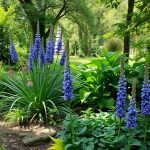Gardening doesn’t have to be all about perfection; sometimes, the wildest ideas are the most refreshing! Here are 31+ creative wild garden ideas to spark your imagination and help you embrace a natural, untamed aesthetic in your outdoor space.
Incorporating Vertical Gardening
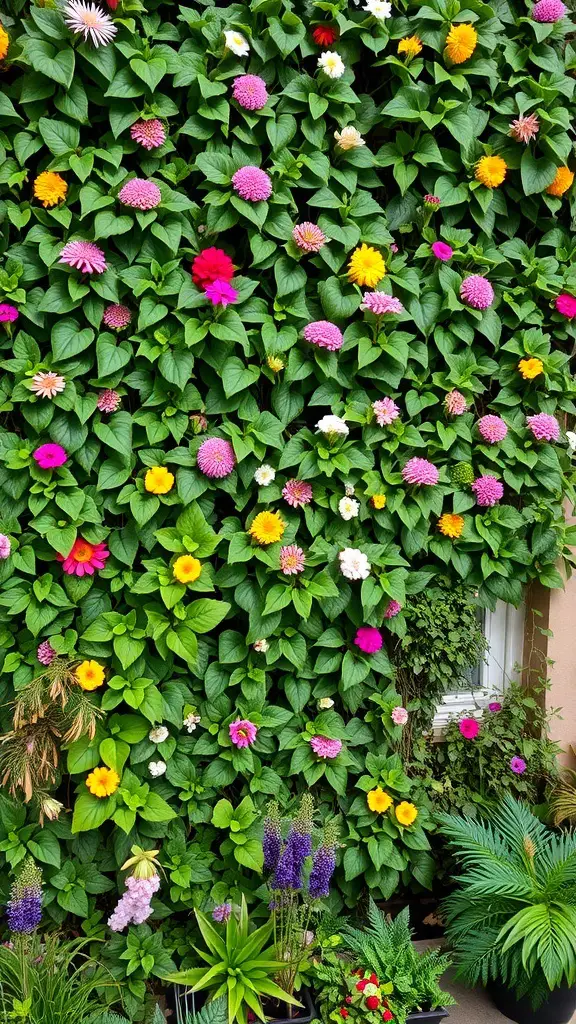
Vertical gardening is a fantastic way to bring life to any space, especially if you’re short on ground area. The image showcases a vibrant wall covered in colorful flowers, creating a stunning visual impact. This approach not only beautifies your surroundings but also maximizes your gardening potential.
Using vertical space allows you to grow a variety of plants, from flowers to herbs. You can use trellises, wall planters, or even repurposed materials like pallets to create your garden. The flowers in the image demonstrate how a mix of colors can brighten up a dull wall, making it a focal point in your garden.
Consider incorporating climbing plants or cascading flowers for added depth. This method encourages creativity, letting you design your garden in unique ways. Whether you have a small balcony or a spacious yard, vertical gardening can transform your space into a lush retreat.
Using Edible Wild Plants
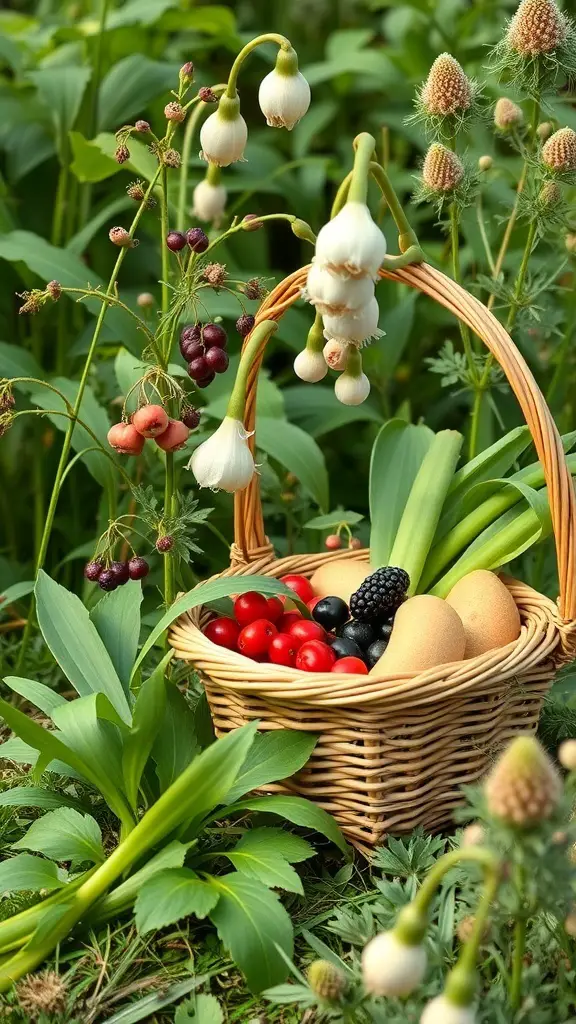
Wild gardens offer a unique chance to incorporate edible plants into your landscape. The image shows a beautiful basket filled with fresh produce, showcasing the bounty of wild gardening. You can see vibrant red and black berries, along with green shoots and eggs, all gathered from nature’s offerings.
Using edible wild plants not only adds flavor to your meals but also connects you with nature. Imagine stepping into your garden and picking fresh ingredients for a salad or a stir-fry. Plants like wild garlic and berries can be easily integrated into your cooking.
Consider creating a small section in your garden dedicated to these wild edibles. You can plant native species that thrive in your area. This not only supports local wildlife but also provides you with fresh, organic food.
Try foraging for wild herbs and greens. Many of them are packed with nutrients and can elevate your dishes. Just make sure to identify them correctly before consuming.
Incorporating these plants into your garden can be a fun and rewarding experience. It encourages sustainability and a deeper appreciation for the environment. Plus, who doesn’t love a garden that feeds you?
Creating a Natural Pathway
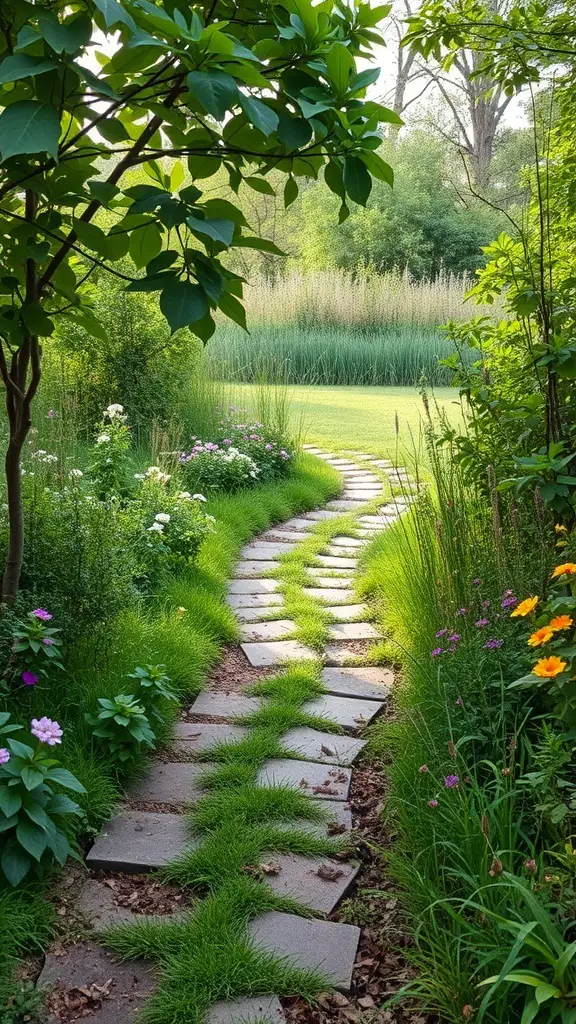
A natural pathway can transform your garden into a welcoming space. Imagine stepping onto a winding stone path, surrounded by lush greenery and vibrant flowers. This image captures that essence perfectly.
The pathway, made of flat stones, meanders through the garden, inviting exploration. The grass peeks through the gaps, softening the look and adding a touch of wildness. This blend of stone and grass creates a harmonious feel.
Consider incorporating various plants along the sides. Bright flowers can add pops of color, while taller grasses provide texture and movement. This combination not only enhances beauty but also supports local wildlife.
Lighting can also play a role. Small lanterns or solar lights along the path can create a magical atmosphere in the evening. Think about how the pathway can lead to different areas of your garden, perhaps a cozy seating spot or a hidden nook.
Incorporating Native Plants
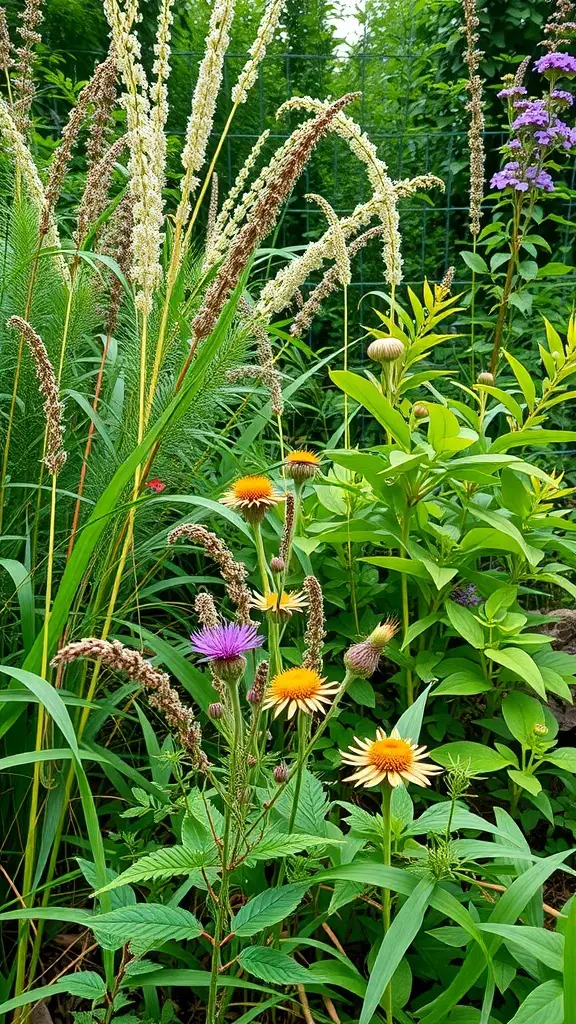
Native plants are a fantastic choice for any wild garden. They thrive in local conditions and require less maintenance than non-native species. This image showcases a vibrant mix of native flora, each contributing to the garden’s beauty and ecosystem.
Look at the colorful flowers, like the bright yellow and purple blooms. These attract pollinators such as bees and butterflies, which are essential for a healthy garden. The tall grasses add texture and movement, creating a lively atmosphere.
When planning your wild garden, consider including a variety of native plants. This not only enhances the visual appeal but also supports local wildlife. Grouping plants with similar water and sunlight needs can make care easier.
Don’t forget to think about the seasons! Choose plants that bloom at different times for year-round interest. A well-planned native garden can be a stunning and sustainable addition to your outdoor space.
Building a Wildlife Habitat

Creating a wildlife habitat in your garden can be a fun and rewarding project. The image shows a vibrant garden filled with colorful flowers, a small pond, and several birdhouses. These elements attract various wildlife, making your garden a lively spot.
Start with birdhouses. The wooden birdhouses in the image are perfect for providing shelter to birds. Place them at different heights to attract various species. Make sure they are safe and secure.
Next, consider adding a water feature. The pond in the image not only looks beautiful but also serves as a drinking and bathing spot for birds and other animals. Surround it with rocks and plants to create a natural look.
Flowers play a key role too. Choose native plants that bloom at different times of the year. This will provide food for pollinators like bees and butterflies. The bright flowers in the image attract attention and invite wildlife.
Lastly, think about the layout. A mix of open spaces and dense plantings offers shelter and foraging opportunities. This balance helps create a thriving ecosystem right in your backyard.
Designing a Wildflower Meadow

Creating a wildflower meadow can be a delightful project. Imagine a space filled with colorful blooms swaying in the breeze. This vibrant scene not only beautifies your garden but also attracts butterflies and bees.
Start by choosing a sunny spot in your yard. Wildflowers thrive in full sunlight, so pick a location that gets plenty of rays. Next, consider the soil type. Most wildflowers prefer well-drained soil, so you might need to amend it if it’s too compacted.
Mix a variety of seeds for a diverse look. Include daisies, poppies, and cornflowers for pops of color. Scatter the seeds in early spring or fall for the best results. Water them lightly to help them settle in.
Maintenance is simple. Once established, wildflowers need minimal care. Just keep an eye out for weeds and enjoy the show as your meadow blooms!
Creating a Pollinator Haven

Creating a pollinator haven is a fantastic way to support local wildlife while enjoying a beautiful garden. Imagine a space filled with vibrant flowers, buzzing bees, and fluttering butterflies. This image showcases a stunning array of colorful blooms, perfect for attracting pollinators.
Start by choosing native plants that thrive in your area. Flowers like daisies, asters, and coneflowers not only look great but also provide essential nectar for bees and butterflies. Mixing different colors and heights adds visual interest and creates a lively atmosphere.
Consider adding some flat-topped flowers, like yarrow or goldenrod, which offer resting spots for pollinators. Incorporating a water source, like a small birdbath, can also help attract these beneficial creatures. A little effort goes a long way in creating a welcoming environment for pollinators.
Lastly, avoid pesticides, as they can harm these important insects. Instead, embrace natural pest control methods. With a little planning, your garden can become a thriving pollinator haven, bringing joy and life to your outdoor space.
Installing a Rain Garden

A rain garden is a fantastic way to manage stormwater while adding beauty to your yard. The image shows a lovely rain garden with a gentle stream flowing through it, surrounded by vibrant plants and flowers. This setup not only looks great but also helps filter rainwater, reducing runoff and promoting healthy soil.
To create a rain garden, start by choosing a spot that collects water after a rain. Dig a shallow basin and fill it with a mix of soil and compost. This will help absorb water and support plant growth. Select native plants that thrive in wet conditions, as they will require less maintenance.
Incorporating stones along the stream adds a natural touch and helps direct water flow. Make sure to leave space for plants to grow around the stones. This design not only enhances the garden’s look but also provides habitats for local wildlife.
Finally, consider adding a small seating area nearby. This creates a peaceful spot to enjoy the beauty of your rain garden while listening to the soothing sounds of flowing water.
Using Natural Mulch and Ground Covers

Natural mulch and ground covers can transform your garden into a vibrant space. The image shows a lovely mix of plants surrounded by organic mulch. This combination not only looks great but also serves practical purposes.
Using natural mulch, like wood chips or bark, helps retain moisture in the soil. It prevents weeds from taking over, allowing your plants to thrive. The texture of the mulch adds a rustic charm, enhancing the garden’s overall appeal.
Ground covers, such as creeping thyme or clover, fill in gaps between larger plants. They create a lush carpet that softens the garden’s look. Plus, they can attract beneficial insects, promoting a healthy ecosystem.
Incorporating these elements can make your garden low-maintenance and beautiful. So, consider adding natural mulch and ground covers to your wild garden ideas!
Incorporating Stone Features
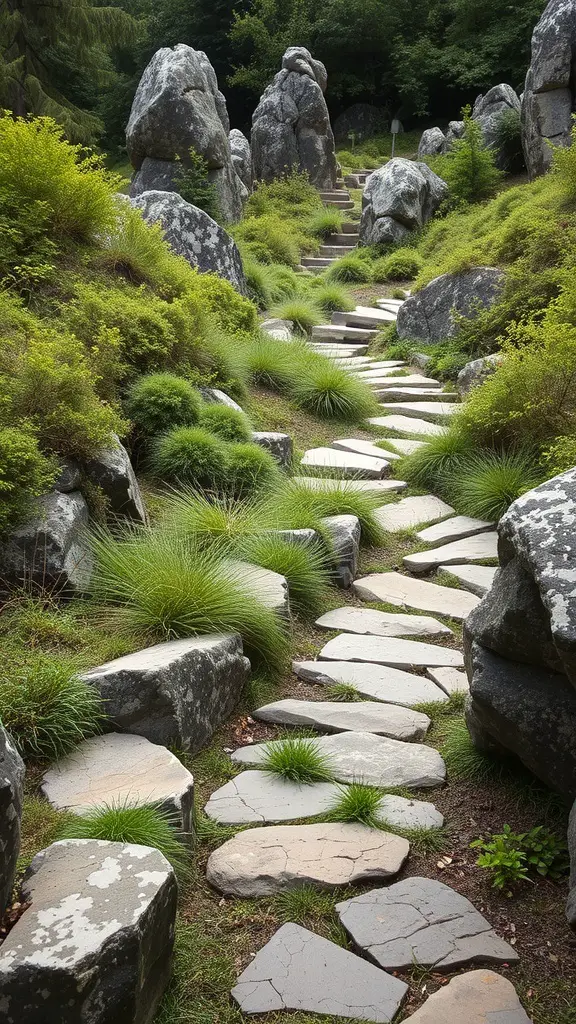
Stone features can add a unique charm to your wild garden. Picture a winding path made of natural stones, leading you through lush greenery. This creates a serene atmosphere that invites exploration.
Using stones of various shapes and sizes can enhance the visual appeal. Large boulders can serve as focal points, while smaller stones can create a textured pathway. This combination adds depth and character to your garden.
Consider surrounding these stone features with native plants. This not only complements the stones but also supports local wildlife. The mix of textures from the stones and plants creates a beautiful contrast.
Another idea is to incorporate stone benches or seating areas. These spots can become perfect places to relax and enjoy your garden. Imagine sipping tea while surrounded by nature’s beauty.
Lastly, don’t forget about lighting. Strategically placed lights can highlight your stone features at night, creating a magical atmosphere. This makes your garden enjoyable even after the sun sets.
Creating a Natural Seating Area

Imagine stepping into a vibrant garden filled with color and life. A natural seating area can be a perfect retreat in your wild garden. Think about placing a cozy bench surrounded by lush greenery and blooming flowers. This creates a welcoming spot to relax and enjoy the beauty around you.
Using natural materials like wood for your seating can blend seamlessly with the garden. Add some soft cushions for comfort and a small table for drinks or snacks. Pathways made of stones can guide you to this peaceful nook, making it feel like a hidden gem.
Consider incorporating climbing plants around the seating area. They can provide shade and a sense of enclosure, making the space feel more intimate. Bright flowers can add pops of color, attracting butterflies and bees, enhancing the garden’s lively atmosphere.
Lighting is another key element. String lights or lanterns can create a magical feel in the evening. This makes your seating area not just a daytime retreat but a cozy evening hangout too. With a little creativity, your natural seating area can become a favorite spot for relaxation and enjoyment.
Designing a Butterfly Garden
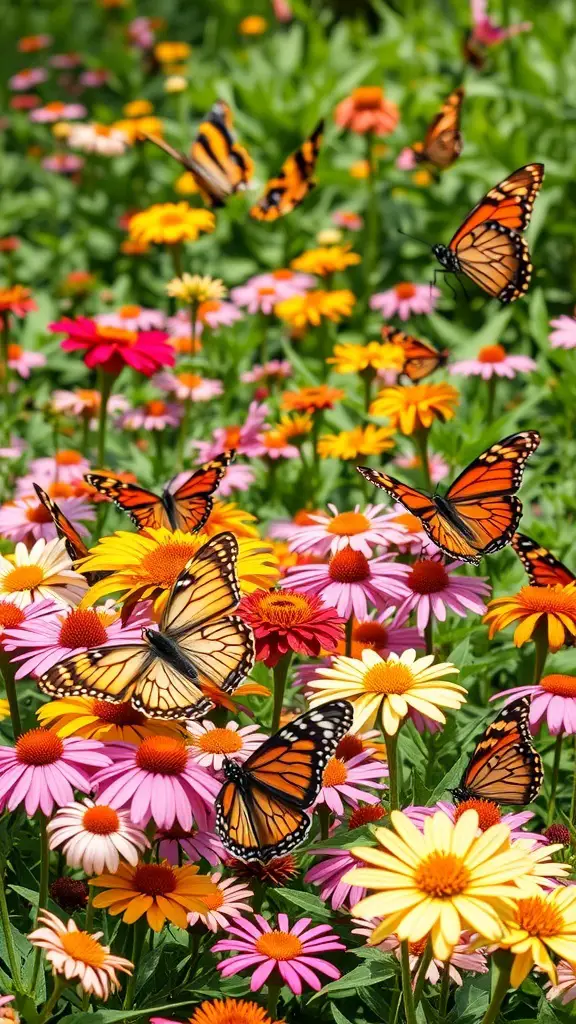
Creating a butterfly garden is a delightful way to invite nature into your space. Imagine vibrant flowers swaying in the breeze, with butterflies fluttering all around. This image perfectly captures that vision, showcasing a colorful array of flowers like daisies and coneflowers, with beautiful butterflies dancing among them.
To start your butterfly garden, choose a variety of nectar-rich plants. Flowers like milkweed, zinnias, and asters are favorites for butterflies. They not only provide food but also create a stunning visual display.
Consider the layout of your garden. Grouping flowers in clusters makes it easier for butterflies to find them. Adding some rocks or logs can create resting spots for these lovely creatures. A small water source, like a shallow dish with pebbles, can also attract butterflies.
Don’t forget about sunlight! Butterflies love warm, sunny spots. Make sure your garden has plenty of sunlight throughout the day. This will help create a lively and inviting atmosphere.
Lastly, be patient. It may take some time for butterflies to discover your garden, but once they do, it will become a beautiful haven for both you and them.
Creating a Seasonal Display
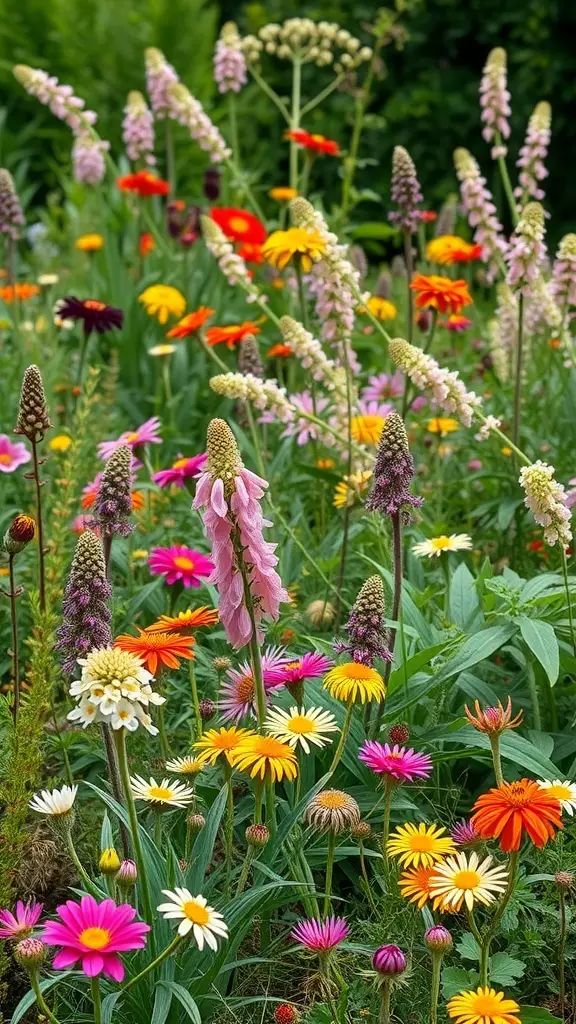
Seasonal displays can bring your garden to life. Imagine a vibrant mix of colors and textures that change with the seasons. This image shows a beautiful wild garden filled with various flowers, each adding its unique charm.
Start by selecting flowers that bloom at different times. This way, you can enjoy a continuous display throughout the year. Consider planting daisies, zinnias, and echinacea for summer, while adding asters and chrysanthemums for fall.
Mixing perennials and annuals can create depth. Perennials will come back year after year, while annuals can be swapped out for fresh colors each season. Don’t forget to add some greenery for contrast!
Using different heights and shapes will make your garden visually appealing. Taller flowers can be placed at the back, with shorter ones in front. This layering effect draws the eye and creates a lush look.
Lastly, think about adding some decorative elements like stones or garden ornaments. These can enhance the seasonal theme and make your garden feel more inviting.
Implementing Companion Planting
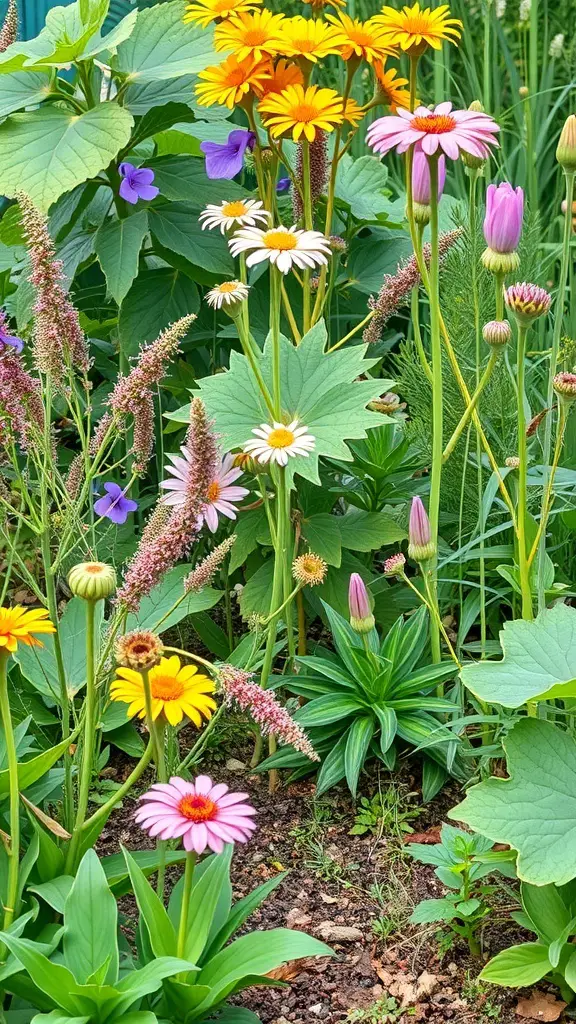
Companion planting is a fantastic way to create a thriving garden. This image shows a vibrant mix of flowers, each playing a role in supporting one another. For example, some plants attract beneficial insects while others can deter pests.
Consider planting marigolds alongside vegetables. They not only add color but also help keep harmful bugs away. You can also pair herbs like basil with tomatoes. Basil enhances the flavor of tomatoes and can help repel pests.
Mixing flowers and vegetables creates a wild garden look while maximizing space and resources. Think about the height and spread of each plant. Taller flowers can provide shade for shorter ones, creating a balanced ecosystem.
Experiment with different combinations to see what works best in your garden. Each plant has its unique benefits, and finding the right companions can lead to a healthier, more productive garden.
Adding Color with Ornamental Grasses

Ornamental grasses are a fantastic way to introduce color and texture to your garden. They sway gently in the breeze, adding movement and life to your outdoor space. The image shows a beautiful mix of grasses with soft, fluffy plumes that catch the light beautifully.
Incorporating these grasses can create a stunning contrast against flowering plants. Notice the bright orange flower peeking through the grasses. This pop of color draws the eye and enhances the overall look of the garden.
Consider using different varieties of ornamental grasses to create layers. Taller grasses can serve as a backdrop, while shorter ones can fill in the front. This layering adds depth and visual interest to your garden.
Don’t forget about seasonal changes! Many ornamental grasses change color or texture throughout the year, providing ongoing beauty. They can also be low-maintenance, making them a great choice for busy gardeners.



